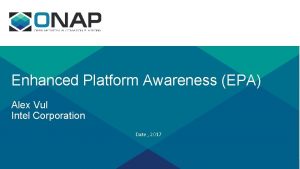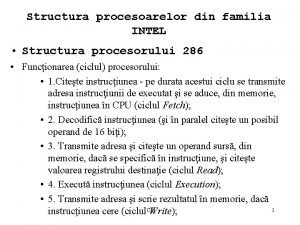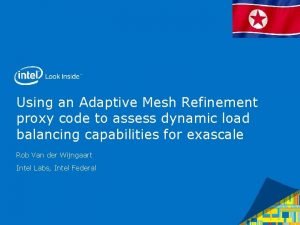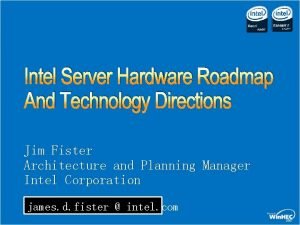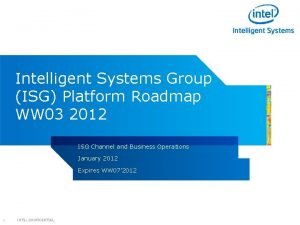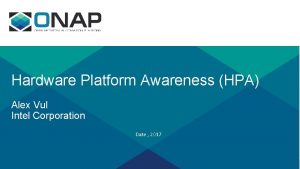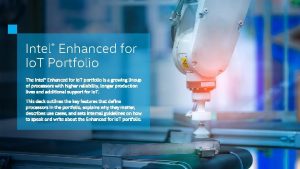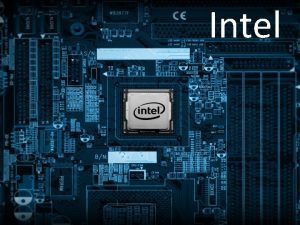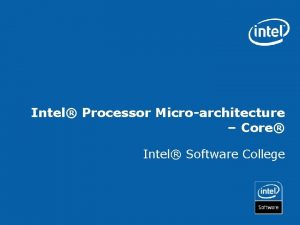Enhanced Platform Awareness EPA Alex Vul Intel Corporation







- Slides: 7

Enhanced Platform Awareness (EPA) Alex Vul Intel Corporation Date , 2017

What is EPA? • Provides awareness of underlying compute hardware platform capabilities to software running on the hardware platform • Provides means platform capability discovery, data collection and consumption • Used to optimize, accelerate or otherwise augment platform software execution 2

Why EPA? • Attract a largest possible ecosystem of commercial VNF suppliers to ONAP, including those who use HW platform features to accelerate and to optimize the performance and throughput of their VNFs • Enable EPA in existing ONAP use cases and all future use cases… • Support S 3 P • Supporting Companies – AT&T, Intel, Cloudify 3

Use within ONAP • In ONAP, EPA is used to optimize and accelerate virtual network function performance and throughput… - Performance • • Get to end-to-end line rate throughput and low latency Deterministic workload performance - Security • • Place workloads on security-enabled HW (e. g. TXT) Optimal security performance (e. g. SSL de/encrypt) - Service Assurance • Telemetry integration to determine post-deployment workload performance • To be utilized by 5 G, v. CPE and Vo. LTE use cases • Addresses S 3 P needs and enables future use cases (5 G) • Scope – for use by VNFs only, other uses not supported 4

Resulting ONAP Functionality 1. Modeling of VNF hardware platform requirements and dependencies as part of the VNFD information model 2. Specification of VNF hardware platform requirements and dependencies as part of the VNF template (TOSCA) 3. Use of VNF hardware platform dependencies at on-boarding time to verify that infrastructure is capable of supporting VNF instantiation and operation 4. Use of VNF hardware platform dependencies as constraints for optimized homing and resource placement of VNF components during VNF instantiation 5. Use of hardware platform health information in determination of the VNF instance health 6. Use of VNF hardware platform dependencies as constraints for operation and remediation of running VNF instances 7. Discovery of hardware platform capabilities exposed by different VIMs 8. Modeling and persistence of discovered platform capabilities in the AA&I database 5

EPA Related ONAP Projects VNF packages are ingested and onboarded VNF Suppliers VNF Packages (CSAR Files) Contain hardware platform requirements EPA driven optimization of compute and storage resource allocation SDC CLAMP (Service Designer) (CL Policy Editor) Catalog POLICY (Service Catalog) (Policy Framework) DB PE EPA-centric policies for VNF placement and operation DB PE PE SO APPC DCAE (Service Orchestration) (Controller) (Monitoring) PE Closed-loop Automation Discovered hardware capabilities are stored in the inventory DB AA&I OOF (Inventory) DB PE Discovery of hardware platform capabilities Policy Enforcement PE Multi-VIM Abstraction Layer Open. Stack Wind. River VMware VIO Azure Kubernetes

ONAP Component Impact Summary Component Impact POLICY Definition of EPA centric constraint policies as they apply to VNF instantiation, VNF resource optimization and VNF instance operation. Multi-VIM Dynamic discovery of hardware platform capabilities during VIM on-boafding and operation. SDC Infrastructure validation during VNF on-boarding, based on ingested VNF hardware dependencies. Propagation of ingested VNF hardware platform dependencies. AAI Modeling and persistence of hardware platform capabilities as part of the inventory information. VNFSDK Specification of VNF hardware platform requirements and dependencies as part of the VNF descriptor. OOF Use of hardware platform requirements as constraints for VNF component homing and resource placement. APP-C Use of hardware platform requirements as constraints for VNF instance operation and remediation. VF-C Use of hardware platform requirements as constraints for VNF instance operation and remediation. SO Use of hardware platform requirements as input into the resource homing and optimization process. DCAE Use of hardware platform telemetry in determination of network service and VNF instance health.
